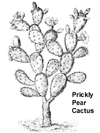When Europeans arrived in Australia from 1776 onwards, they brought English plants and animals, hoping to replicate "home". Some organisms were deliberately introduced for food (cattle, pigs, goats, blackberries and the like), for recreation (foxes and rabbits for hunting, carp and redfin for fishing, and gorse to grow steeplechase fencing), for work and transport (camel, buffalo) and for ornamentation (hawthorn bushes for hedges and prickly pear cactus for gardens). Others such as mice, rats, and thistles were introduced unintentionally.
In a balanced ecosystem, no particular population grows unchecked due to control by predators, and restrictions of limiting factors such as space, shelter, water and food (see Graphing populations in food chains).
In the vastly different conditions of Australia, many introduced species thrived and competed more successfully for water and food than the native species. Their numbers soared without the normal predators from their homeland and they quickly became pests (unwanted animals) and weeds (unwanted plants). Some domesticated species became wild (feral), killing native species and changing the balance of the ecosystem.
Case study: Rabbits
About a dozen rabbits were introduced on to a property near Geelong in
1859 to breed for hunting. They spread widely and bred rapidly, soon covering
about two thirds of Australia. They competed for pasture more efficiently
than sheep, they dug burrows in the dry sandy soil and, most importantly,
they lacked their usual European predators such as foxes. Their numbers
soared with often five litters a year produced. Desperate farmers tried
laying poisoned bait (chemical control) but this often killed other native
species as well. They ripped up burrows (mechanical control), but this
was labour intensive, expensive and not particularly beneficial. Eventually,
a highly infectious mosquito-borne viral disease called myxomatosis was
introduced (biological control) which had extremely widespread success
specific to rabbits. Unfortunately, some rabbits were not killed. They
were resistant to "myxo". Their offspring inherited this resistance,
which means that, although many millions of rabbits died, more and more
resistant ones were breeding and "myxo" became far less effective,
and rabbit numbers grew again. The "calicivirus" was released
in 1995 in South Australia. This kills rabbits within 40 hours, but the
virus only spreads in some climatic conditions which means that it hasn't
been as successful as scientists had initially hoped.
Case study: Prickly pear cactus
A prickly pear plant was introduced from South America in the late nineteenth
century for ornamental reasons. It reproduces both asexually by regrowth
of broken portions, and sexually with tasty fruits eaten by birds and
animals and the seeds dropped elsewhere. It grew rapidly and was planted
as fencing for cattle. Then it spread unchecked as it lacked any insect
feeders to control its growth. The CSIRO carefully tested 13 South American
natural insect enemies of the prickly pear to be certain they wouldn't
damage Australian native or commercial crops. In 1925, eggs of the caterpillar
Cactoblastis were released. As the caterpillars grew into adult moths,
they moved onto new outbreaks of the cactus soon bringing the problem
into a natural balance. This use of other organisms to control introduced
species is called Biological control .
Other examples
 The cane toad, introduced into the Queensland canefields to reduce
pests, is still multiplying and spreading virtually unchecked. Research
into biological control has proved unsuccessful so far. There are control
mechanisms to prevent its spread south.
The cane toad, introduced into the Queensland canefields to reduce
pests, is still multiplying and spreading virtually unchecked. Research
into biological control has proved unsuccessful so far. There are control
mechanisms to prevent its spread south.
European carp have spread widely and quickly through inland waterways since their introduction. Their feeding patterns disturb the bottom sediments, making the water too muddy for many native species of fish (such as Murray Cod) to feed or breed.
| Copyright owned by the State of Victoria (Department of Education and Early Childhood Development). Used with Permission. |
|
|||||||||||||||||||||||||||||||||||||||||||||||||||||||||||||||||||||||||||||||||||||